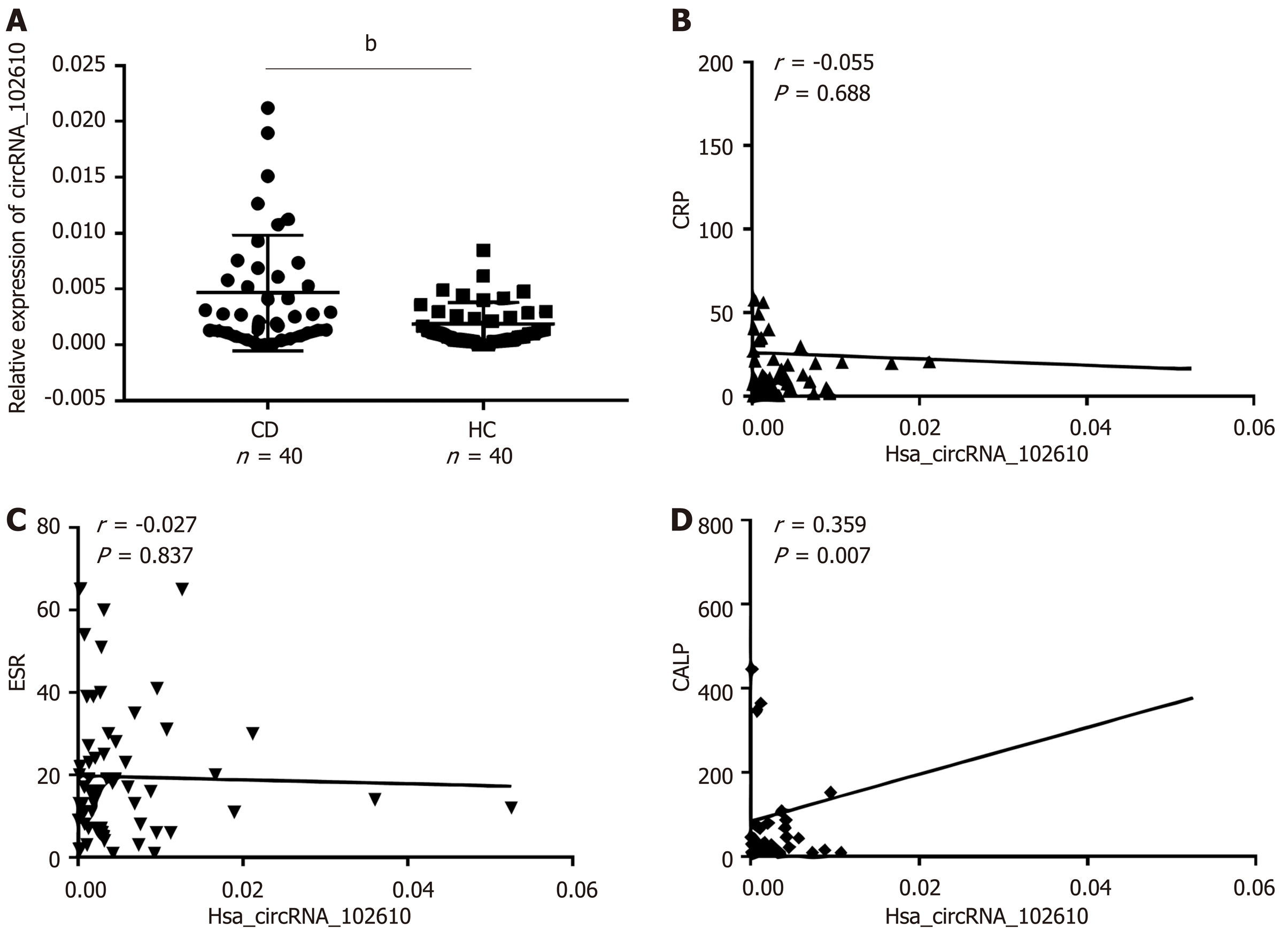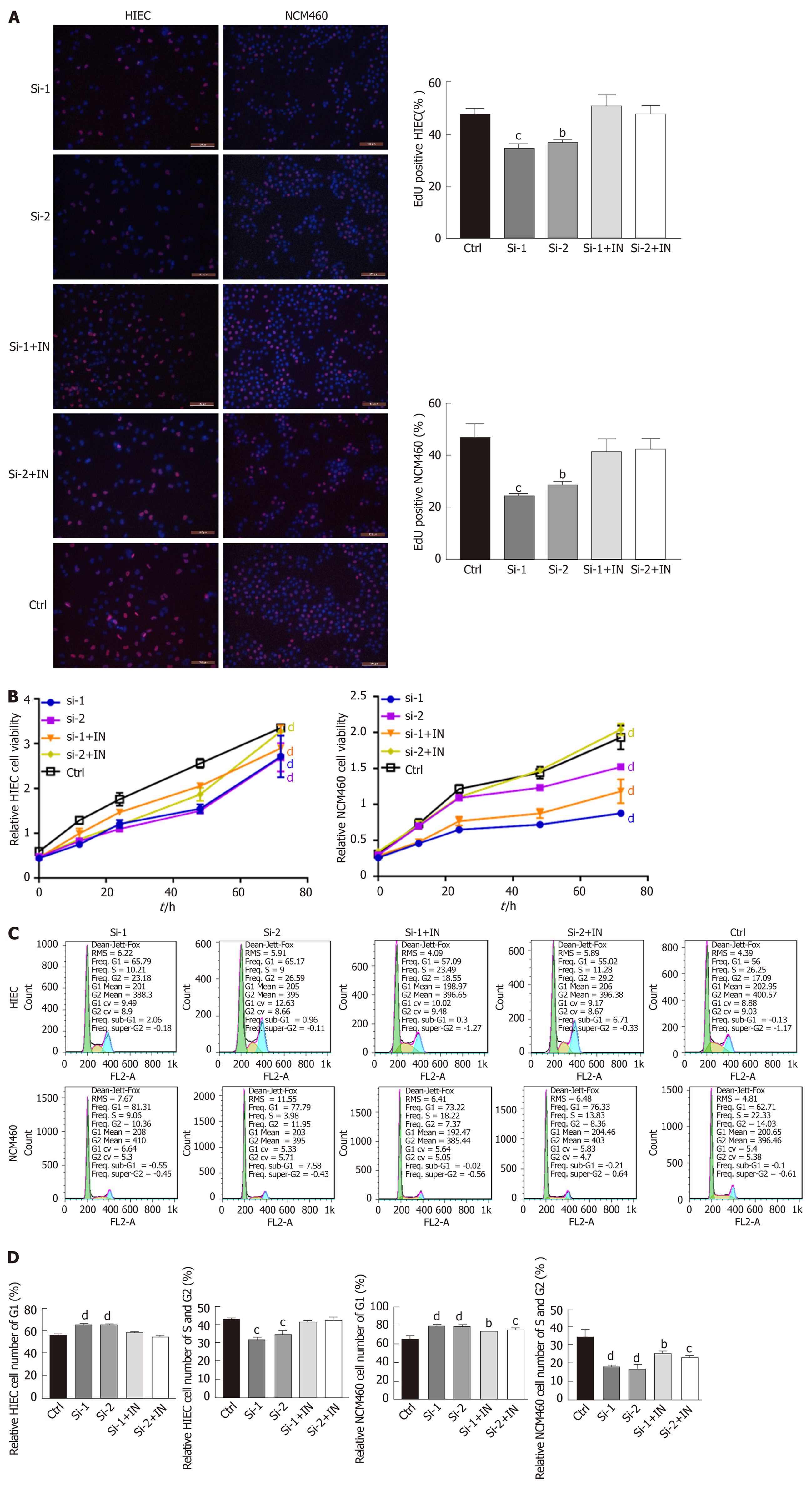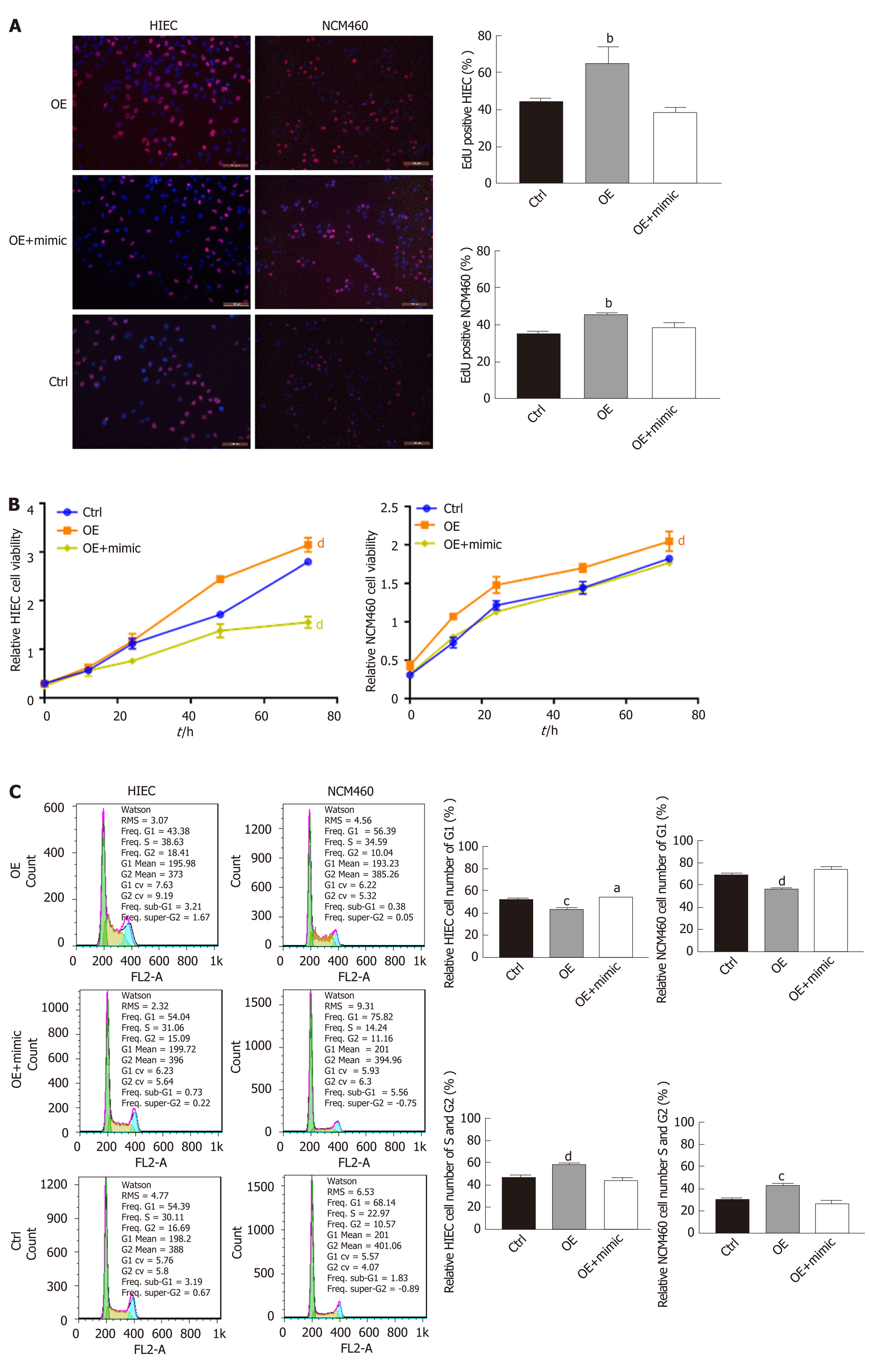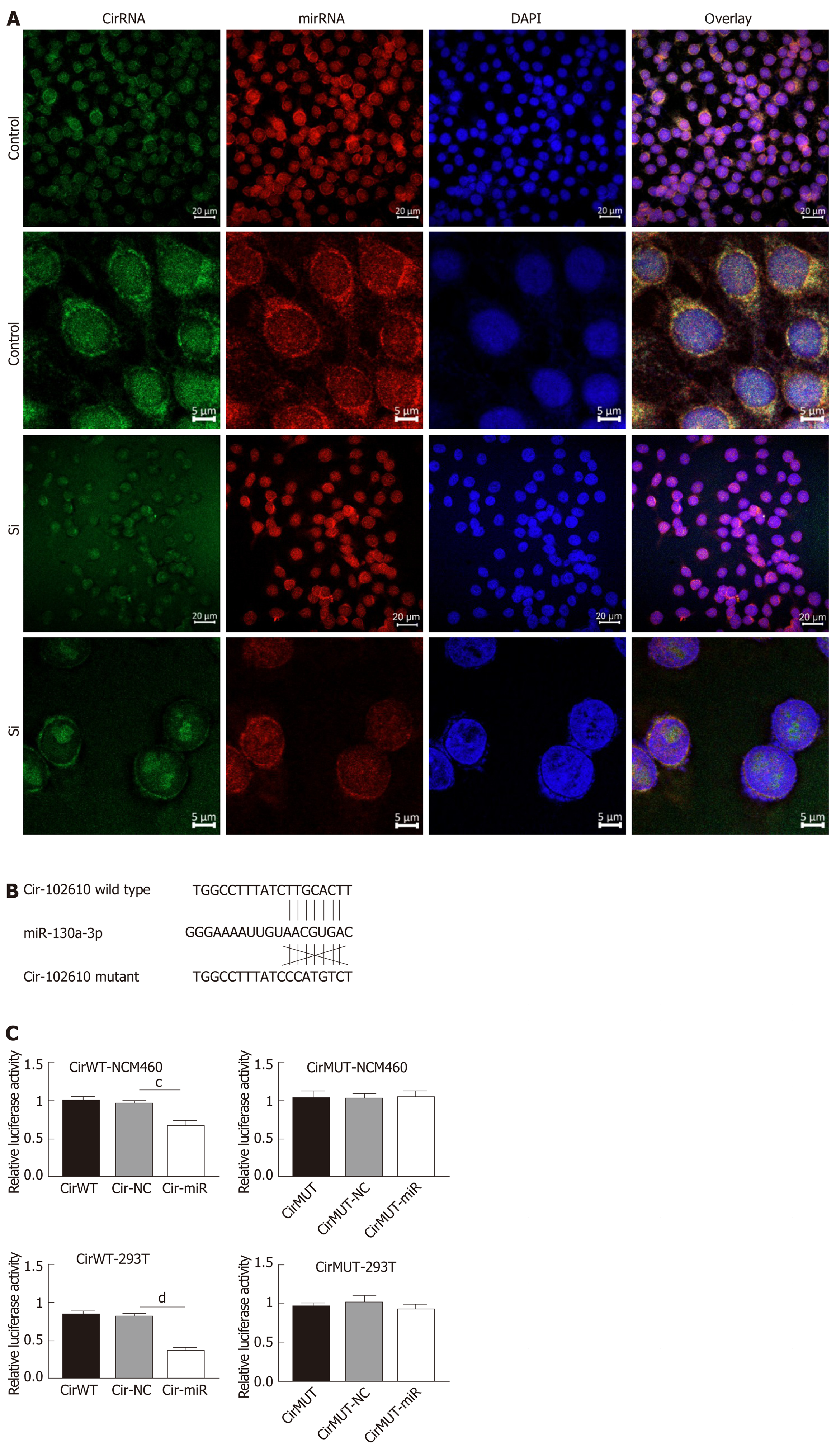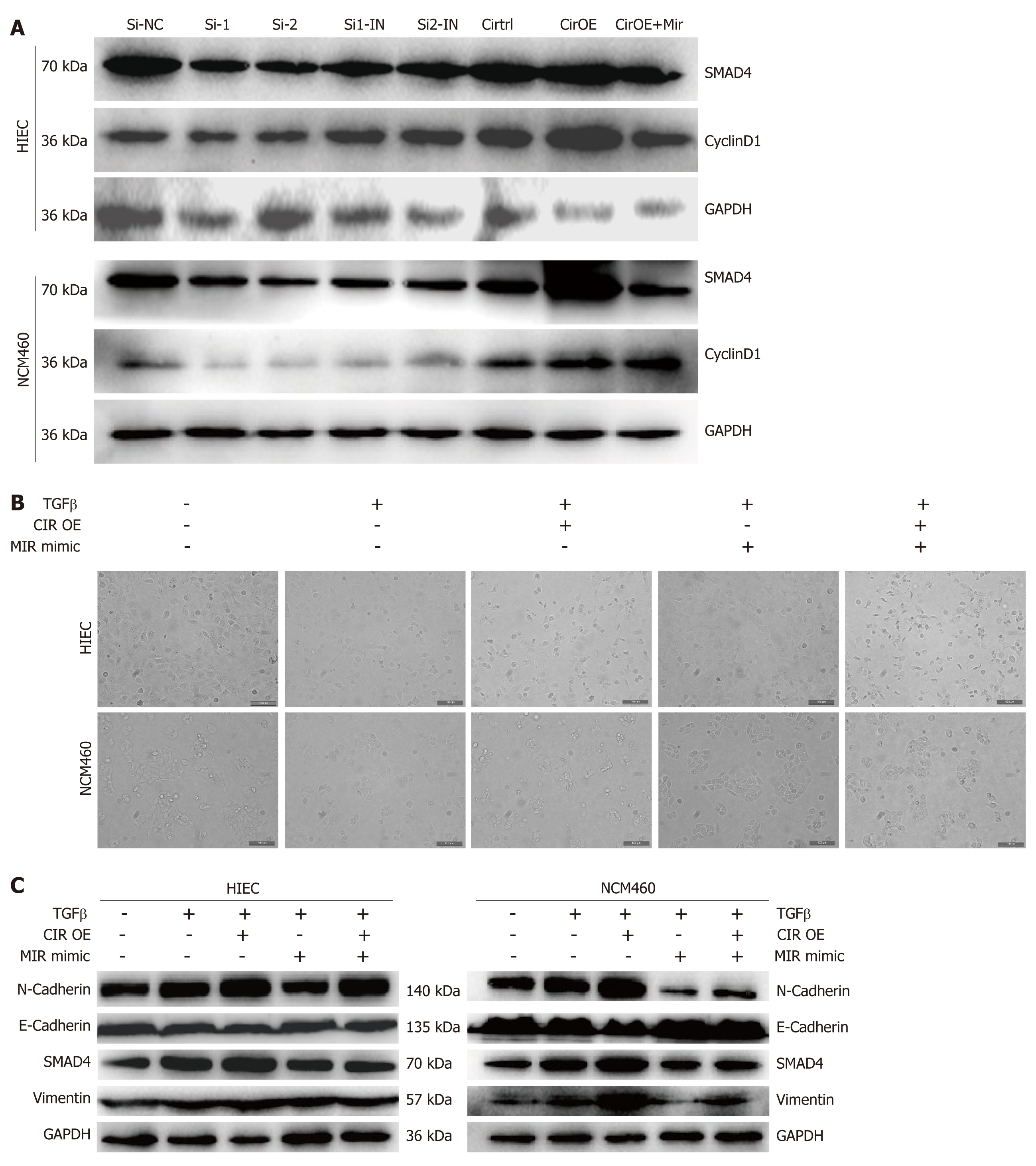Copyright
©The Author(s) 2020.
World J Gastroenterol. Jun 14, 2020; 26(22): 3034-3055
Published online Jun 14, 2020. doi: 10.3748/wjg.v26.i22.3034
Published online Jun 14, 2020. doi: 10.3748/wjg.v26.i22.3034
Figure 1 Correlation analysis between hsa_circRNA_102610 and erythrocyte sedimentation rate, C-reactive protein, and calprotectin in Crohn’s disease patients.
A: Relative expression of hsa_circRNA_102610 in Crohn’s disease (CD) patients (n = 40) and healthy controls (HC, n = 40); B: Correlation analysis of hsa_circRNA_102610 and C-reactive protein in CD patients; C: Correlation analysis of hsa_circRNA_102610 and erythrocyte sedimentation rate in CD patients; D: Correlation analysis of hsa_circRNA_102610 and calprotectin in CD patients. bP < 0.01 vs HC. CRP: C-reactive protein; ESR: Erythrocyte sedimentation rate; CALP: Calprotectin; CD: Crohn’s disease.
Figure 2 Hsa_circRNA_102610 overexpression promoted human intestinal epithelial cells and normal-derived colon mucosa cell line 460 cell proliferation.
A: 5-ethynyl-2’-deoxyuridine-staining of human intestinal epithelial cells. Red: 5-ethynyl-2’-deoxyuridine staining; blue: Hoechst 33342 staining; B: Relative HIEC and normal-derived colon mucosa cell line 460 cell viability, as measured by the cell counting kit-8 assay; C: Cell cycle phase detection for HIECs and normal-derived colon mucosa cell line 460 cells by flow cytometry. aP < 0.05 vs Ctrl, bP < 0.01 vs Ctrl, cP < 0.001 vs Ctrl, dP < 0.0001 vs Ctrl. Si-1 and Si-2: siRNAs mediating hsa_circRNA_102610 downregulation. OE: Hsa_circRNA_102610 overexpression by transient transfection. Ctrl: Control; HIECs: Human intestinal epithelial cells; NCM460: Normal-derived colon mucosa cell line 460; EdU: 5-ethynyl-2’-deoxyuridine.
Figure 3 Functional prediction of hsa_circRNA_102610 by bioinformatics analysis.
A: Pathway analysis of the validated upregulated circRNAs (092520, 102610, 004662, and 103124) in Crohn’s disease (CD); B: Hierarchical clustering analysis of upregulated circRNAs in CD that might play roles in epithelial-mesenchymal transition according to miRNA response element analysis. Hsa_circRNA_102610 was included; C: miRNA response element analysis of hsa_circRNA_102610. Binding sites were predicted between hsa_circRNA_102610 and hsa-miR-130a-3p, hsa-miR-130b-3p, hsa-miR-136-5p, hsa-miR-330-3p, and hsa-miR-513a-3p. The databases miRanda and TargetScan were used for this prediction; D: Interaction network of hsa_circRNA_102610, the top 5 possibly binding miRNAs, and the corresponding proteins; E: Analysis of hsa-miR-130a-3p expression by reverse transcription quantitative polymerase chain reaction and its correlation with hsa_circRNA_102610 expression in CD patients. aP < 0.05 vs healthy controls. CD: Crohn’s disease patients; HC: Healthy controls.
Figure 4 Hsa-miR-130a-3p inhibitor reversed the effect of hsa_circRNA_102610 knockdown on intestinal epithelial cells.
A: 5-ethynyl-2’-deoxyuridine-staining of human intestinal epithelial cells and normal-derived colon mucosa cell line 460 (NCM460) cells. Red: 5-ethynyl-2’-deoxyuridine staining; blue: Hoechst 33342 staining; B: Relative HIEC and NCM460 cell viability, as measured by the cell counting kit-8 assay; C: Cell cycle detection of human intestinal epithelial cells or NCM460 cells by flow cytometry. Control: Negative control transfected with siRNA negative control. aP < 0.05 vs Ctrl, bP < 0.01 vs Ctrl, cP < 0.001 vs Ctrl, dP < 0.0001 vs Ctrl. Si-1, Si-2, siRNA interference of hsa_circRNA_102610. Si-1+IN, Si-2+IN, cotransfection of hsa_circRNA_102610 siRNA and hsa-miR-130a-3p inhibitor. Ctrl: Control; EdU: 5-ethynyl-2’-deoxyuridine; NCM460: Normal-derived colon mucosa cell line 460; HIECs: Human intestinal epithelial cells. Bar: × 100 μm.
Figure 5 Hsa-miR-130a-3p mimics reversed the cell proliferation promoting effect of hsa_circRNA_102610 overexpression.
A: 5-ethynyl-2’-deoxyuridine staining of human intestinal epithelial cells (HIECs) and normal-derived colon mucosa cell line 460 (NCM460) cells. Red: 5-ethynyl-2’-deoxyuridine stained; Blue: Hoechst 33342 stained; B: Relative HIEC and NCM460 cell viability measured by the cell counting kit-8 test; C: Cell cycle phase of HIECs for NCM460 cells by flow cytometry. aP < 0.05 vs Ctrl, bP < 0.01 vs Ctrl, cP < 0.001 vs Ctrl, dP < 0.0001 vs Ctrl. OE: Hsa_circRNA_102610 overexpression by pLC5-ciR plasmid transfection; Ctrl: Transfection with the overexpression negative control pLC5-ciR null vector. OE + mimics: Cotransfection with the hsa_circRNA_102610 overexpression plasmid and hsa-miR-130a-3p mimics. NCM460: Normal-derived colon mucosa cell line 460; HIECs: Human intestinal epithelial cells. Bar: ×100 μm.
Figure 6 Hsa_circRNA_102610 was confirmed to interact with hsa-miR-130a-3p via fluorescence in situ hybridization and luciferase reporter assays.
A: Hsa_circRNA_102610 and hsa-miR-130a-3p were detected in normal-derived colon mucosa cell line 460 cells by fluorescence in situ hybridization using FAM- and CY3-labeled specific probes siRNA-mediated hsa_circRNA_102610 downregulation. 4’, 6-diamidino-2-phenylindole was used to stain nuclei; B: Mutation site of hsa_circRNA_102610 in the miRNA response element of hsa-miR-130a-3p; C: Relative luciferase activity in normal-derived colon mucosa cell line 460 and 293T cells following transfection with psiCHECK-2 plasmids expressing the wild-type (CirWT) or mutated miRNA response element of hsa_circRNA_102610. Cells were cotransfected with hsa-miR-130a-3p mimics or negative control constructs. cP < 0.001 vs CirWT-NC, dP < 0.0001 vs CirWT-NC. Bar: ×5 μm. DAPI: 4’, 6-diamidino-2-phenylindole; MRE: miRNA response element; CirWT: PsiCHECK-2 plasmids expressing the wild-type; CirMUT: PsiCHECK-2 plasmids expressing the mutated; NC: Negative control constructs; NCM460: Normal-derived colon mucosa cell line 460.
Figure 7 Overexpression of hsa_circRNA_102610 promoted mothers against decapentaplegic homolog 4 and CyclinD1 protein expression, and transforming growth factor-β1-induced epithelial-mesenchymal transition in human intestinal epithelial cells and normal-derived colon mucosa cell line 460 (NCM460) cells.
A: Western-blot detection of mothers against decapentaplegic homolog 4 and CyclinD1 expression following hsa_circRNA_102610 downregulation or overexpression in human intestinal epithelial and NCM460 cells. Downregulation of hsa_circRNA_102610 was conducted by siRNA (Si-1, Si-2), and a hsa-miR-130a-3p inhibitor was included to reverse the effects of the siRNAs (Si1-IN, Si2-IN). Si-NC was the negative control for siRNA interference. Hsa_circRNA_102610 was overexpressed after pLC5-ciR plasmid transfection, and hsa-miR-130a-3p mimics were included to reverse the effect of hsa_circRNA_102610 overexpression (CirOE-Mir). Cirtrl was the overexpression negative control pLC5-ciR null vector transfection; B: human intestinal epithelial cell and normal-derived colon mucosa cell line 460 (NCM460) cell morphology following transforming growth factor-β1 (TGF-β1) treatment. The cell-cell junctions were reduced in TGF-β1 treated cells, and hsa_circRNA_102610 overexpression promoted this effect. Conversely, hsa-miR-130a-3p mimics protected cells from morphological changes, and hsa_circRNA_102610 overexpression reversed this effect; C: Western blot detection of mothers against decapentaplegic homolog 4, N-Cadherin, E-Cadherin, and Vimentin in human intestinal epithelial cells and NCM460 cells following TGF-β1 treatment. CIR OE: hsa_circRNA_102610 overexpression by pLC5-ciR plasmid transfection. MIR mimic: Transfection with hsa-miR-130a-3p mimics; SMAD4: Mothers against decapentaplegic homolog 4; Cir OE: Hsa_circRNA_102610 was overexpressed after pLC5-ciR plasmid transfection; CirOE-Mir: Hsa-miR-130a-3p mimics were included to reverse the effect of hsa_circRNA_102610 overexpression; TGF-β1: Transforming growth factor-β1. Bar: × 100 μm.
Figure 8 Proposed model by which hsa_circRNA_102610 promotes growth and transforming growth factor-β1-induced epithelial-mesenchymal transition of intestinal epithelial cells by sponging hsa-miR-130a-3p.
This schematic was generated by Pathway Builder Tool 2.0. Hsa_circRNA_102610 promotes TGFβ1-induced epithelial-mesenchymal transition by sponging hsa-miR-130a-3p and blocking the inhibitory effect of hsa-miR-130a-3p on Mothers against decapentaplegic homolog 4. The expression of CyclinD1, Vimentin and N-Cadherin is promoted, while the expression of E-Cadherin is inhibited. SMAD4: Mothers against decapentaplegic homolog 4; TGF-β1: Transforming growth factor-β1.
- Citation: Yin J, Ye YL, Hu T, Xu LJ, Zhang LP, Ji RN, Li P, Chen Q, Zhu JY, Pang Z. Hsa_circRNA_102610 upregulation in Crohn’s disease promotes transforming growth factor-β1-induced epithelial-mesenchymal transition via sponging of hsa-miR-130a-3p. World J Gastroenterol 2020; 26(22): 3034-3055
- URL: https://www.wjgnet.com/1007-9327/full/v26/i22/3034.htm
- DOI: https://dx.doi.org/10.3748/wjg.v26.i22.3034









